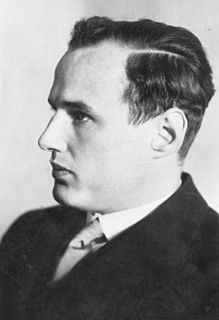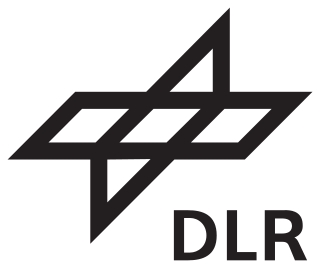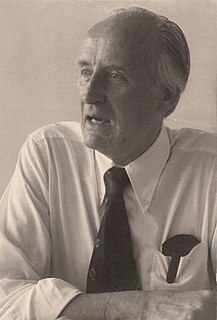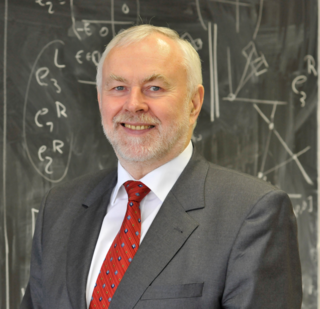Related Research Articles
Peter Armbruster is a German physicist at the Gesellschaft für Schwerionenforschung (GSI) facility in Darmstadt, Germany, and is credited with co-discovering elements 107 (bohrium), 108 (hassium), 109 (meitnerium), 110 (darmstadtium), 111 (roentgenium), and 112 (copernicium) with research partner Gottfried Münzenberg.

Manfred von Ardenne was a German researcher and applied physicist and inventor. He took out approximately 600 patents in fields including electron microscopy, medical technology, nuclear technology, plasma physics, and radio and television technology. From 1928 to 1945, he directed his private research laboratory Forschungslaboratorium für Elektronenphysik. For ten years after World War II, he worked in the Soviet Union on their atomic bomb project and was awarded a Stalin Prize. Upon his return to the then East Germany, he started another private laboratory, Forschungsinstitut Manfred von Ardenne.

The German Aerospace Center, abbreviated DLR, is the national center for aerospace, energy and transportation research of Germany, founded in 1969. It is headquartered in Cologne with 35 locations throughout Germany. The DLR is engaged in a wide range of research and development projects in national and international partnerships. DLR also acts as the German space agency and is responsible for planning and implementing the German space programme on behalf of the German federal government. As a project management agency, DLR coordinates and answers the technical and organisational implementation of projects funded by a number of German federal ministries.
TU Dresden is a public research university, the largest institute of higher education in the city of Dresden, the largest university in Saxony and one of the 10 largest universities in Germany with 32,389 students as of 2018.

The Uranverein or Uranprojekt was the name given to the project in Germany to research nuclear technology, including nuclear weapons and nuclear reactors, during World War II. It went through several phases of work, but in the words of historian Mark Walker, it was ultimately "frozen at the laboratory level" with the "modest goal" to "build a nuclear reactor which could sustain a nuclear fission chain reaction for a significant amount of time and to achieve the complete separation of at least tiny amount of the uranium isotopes." The scholarly consensus is that it failed to achieve these goals, and that despite fears at the time, the Germans had never been close to producing nuclear weapons.
The Gottfried Wilhelm Leibniz Prize, in short Leibniz Prize, is awarded by the German Research Foundation to "exceptional scientists and academics for their outstanding achievements in the field of research". Since 1986, up to ten prizes are awarded annually to individuals or research groups working at a research institution in Germany or at a German research institution abroad. It is considered the most important research award in Germany.

Helmut Gröttrup was a German engineer, rocket scientist and inventor of the smart card. During World War II, he worked in the German V-2 rocket program under Wernher von Braun. From 1946 to 1950 he headed a group of 170 German scientists who were forced to work for the Soviet rocketry program under Sergei Korolev. After returning to West Germany in December 1953, he developed data processing systems and contributed to early commercial applications of computer science. In 1967 Gröttrup invented the basic principles of the smart card as a forgery-proof "key" for secure identification and access control.

The Karlsruhe Institute of Technology is a public research university in Karlsruhe, Germany. The institute is a national research center of the Helmholtz Association.

Kaunas University of Technology is a public research university located in Kaunas, Lithuania. Established in 1922, KTU has been one of the top centers of Lithuanian science education. According to Lithuanian National University Rankings conducted in 2021, KTU was the second best university in Lithuania. The primary language of education is Lithuanian, though there are courses that are taught jointly in Lithuanian and English or solely English.

Gorodomlya Island is located on Lake Seliger in Tver Oblast, Russia, 300 kilometres (200 mi) northwest of Moscow. The closed urban-type settlement of Solnechny is located on the island.

Jürgen Rohwer was a German military historian and professor of history at the University of Stuttgart. Rohwer wrote over 400 books and essays on World War II naval history and military intelligence, which gained him worldwide recognition as a prominent historian and a leading authority on U-boats.

Operation Osoaviakhim was a secret Soviet operation under which more than 2,500 former Nazi German specialists (Специалисты; i.e. scientists, engineers and technicians who worked in specialist areas) from companies and institutions relevant to military and economic policy in the Soviet occupation zone of Germany (SBZ) and the Soviet sector of Berlin, as well as around 4,000 more family members, totalling more than 6,000 people, were transported from former Nazi Germany as war reparations in the Soviet Union. It took place in the early morning hours of October 22, 1946 when MVD and Soviet Army units under the direction of the Soviet Military Administration in Germany (SMAD), headed by Ivan Serov.

Heinz Maier-Leibnitz was a German physicist. He made contributions to nuclear spectroscopy, coincidence measurement techniques, radioactive tracers for biochemistry and medicine, and neutron optics. He was an influential educator and an advisor to the Federal Republic of Germany on nuclear programs.

Detlef Zuehlke is a German engineer and professor.
The Ludwig Prandtl Ring is the highest award of the Deutsche Gesellschaft für Luft- und Raumfahrt, awarded "for outstanding contribution in the field of aerospace engineering". The award is named in honour of Ludwig Prandtl.

Martin Grötschel is a German mathematician known for his research on combinatorial optimization, polyhedral combinatorics, and operations research. From 1991 to 2012 he was Vice President of the Zuse Institute Berlin (ZIB) and served from 2012 to 2015 as ZIB's President. From 2015 to 2020 he was President of the Berlin-Brandenburg Academy of Sciences and Humanities (BBAW).
Friedrich Lütge was a German economist, social historian and economic historian.
The Department of Electrical Engineering and Information Technology (etit) is a department of the Technische Universität Darmstadt. It was the first faculty of electrical engineering in the world and offered the first course of study in electrical engineering.
Robert Piloty was a German computer scientist and former Professor of Communications Processing at the Faculty of Electrical Engineering of the Technische Universität Darmstadt. He was one of the pioneers in the construction of program-controlled computer systems and the founding father of computer science courses in Germany. As a member of the advisory board and chairman of the commission for the introduction of computer science studies in Germany, he was significantly involved in the introduction and design of computer science studies throughout Germany. His efforts also led to the establishment of the first computer science course in Germany at TU Darmstadt.

Ernst Emil Max Gall was a German art historian and historic preservationist.
References
- 1 2 3 4 5 6 7 8 Gedenktafel für Prof. Kurt Magnus enthüllt. Pionier der Mechatronik für sein Lebenswerk geehrt, Technische Universität München, July 20, 2018
- ↑ Werner Schiehlen, "From cybernetics to mechatronics: Seven decades of interdisciplinary engineering", PAMM · Proc. Appl. Math. Mech., vol. 19, 2019, pp. 1-4, doi : 10.1002/pamm.201900108
- ↑ Anatoly Zak, "German A-4 team in Moscow" (retrieved October 13, 2022)
- ↑ Magnus, Kurt (1993). Raketensklaven. Deutsche Forscher hinter rotem Stacheldraht[Rocket slaves: German research behind red barbwire] (in German). Stuttgart: Deutsche Verlagsanstalt. pp. 202–211. ISBN 978-3421066350.